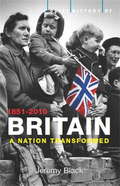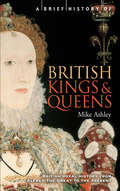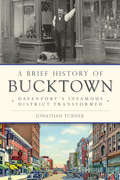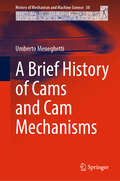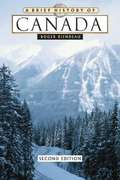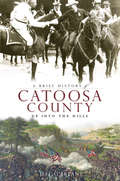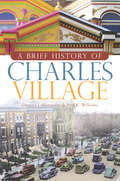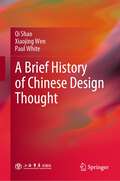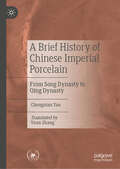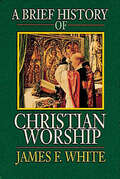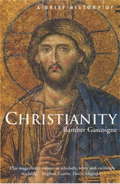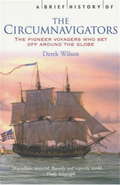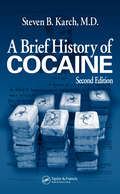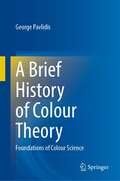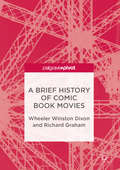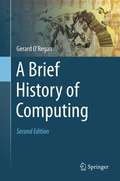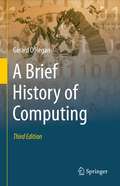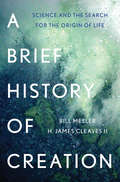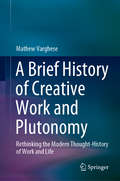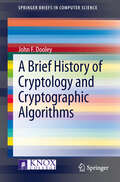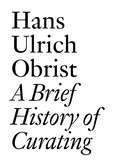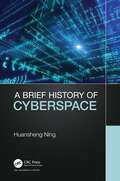- Table View
- List View
A Brief History of Britain 1851-2021: From World Power to ? (Brief Histories)
by Jeremy BlackFrom the Great Exhibition's showcasing of British national achievement in 1851 to the opening ceremonies of the Olympics in Stratford in 2012 and on to Brexit, an insightful exploration of the transformation of modern BritainThis revised and updated fourth and final volume in the concise Brief History of Britain series begins in the specially-constructed Crystal Palace, three times the length of St Paul's Cathedral, in Hyde Park at the beginning of the second half of the nineteenth century. The Great Exhibition it housed marked a high point of British national achievement, at the forefront of the Industrial Revolution, at the heart of a great empire, with Queen Victoria still to reign for fifty years. It was a time of confidence in the future, and exuberant patriotism for Britain's role in it.The beginning of the Second World War in 1939 marks a turning point because of the great change it heralded in Britain's global standing. At its peak, protected by the world's greatest navy, the British Empire stretched from Australasia to Canada, from Hong Kong and India to South Africa, and from Jamaica to the Falklands. Now the empire is no more: a fundamental change not only for the world, but also for Britain. The Second World War had been won, but it had exhausted Britain and marked the beginning of its national decline.Black links cultural and political developments closely - transport, health, migration and economic and demographic factors - in order to make clear how porous and changeable the manifestations of national civilisation can be, and to make sense of themes such as the triumph of town over country, Britain's international clout and the shift from the dominance of the market at the turn of the nineteenth century to the growing significance of the state. Importantly, he also looks at how public history has presented the nation's past, and how the changing and different ways we look at that past are central aspects of our shared history.
A Brief History of British Kings & Queens (Brief History)
by Mike AshleyHere is the whole of recorded British royal history, from the legendary King Alfred the Great onwards, including the monarchies of England, Scotland, Wales and the United Kingdom for over a thousand years. <P><P>Fascinating portraits are expertly woven into a history of division and eventual union of the British Isles - even royals we think most familiar are revealed in a new and sometimes surprising light. This revised and shortened edition of The Mammoth Book of British Kings & Queens includes biographies of the royals of recorded British history, plus an overview of the semi-legendary figures of pre-history and the Dark Ages - an accessible source for students and general readers.
A Brief History of Bucktown: Davenport's Infamous District Transformed (Brief History)
by Jonathan TurnerGerman immigrants created leafy beer gardens here nearly two centuries ago, establishing Bucktown as the heart of entertainment in downtown Davenport for generations. In 1916, the founding of the Tri-City Symphony Orchestra at the Burtis Opera House embodied the neighborhood's reputation for high culture. The numerous saloons and theaters, as well as the forty-two documented brothels that flourished within two blocks, lent a bawdy side to the good times. Varied industries thrived through World War II, and downtown bustled with shoppers visiting department stores like Petersen's. Later, the neighborhood struggled and declined as a farming crisis hit the region hard. With revitalized landmarks like the magnificent Hotel Blackhawk and the historic Redstone Building, the community is growing more vibrant as a place to live, work and play. Author Jonathan Turner explores this dynamic history and transformation.
A Brief History of Cams and Cam Mechanisms (History of Mechanism and Machine Science #50)
by Umberto MeneghettiThis book offers a description of the evolution of cams and their uses from the Middle Ages to the present day, highlighting their contribution to the development of technology. Usually, in the history of technology the diverse types of machines are taken into account, but the importance of cams is not emphasized, which are often fundamental for the operation of such machines. In this book the focus is instead on cams, understood as important, and often essential, components of machines that have had significant importance in the development of technology. It treats technical aspects at a level easily accessible even to non-experts in mechanics and the various applications are illustrated with many figures. The book serves as a reference work for those interested in both the history of technology and machines in general, and it helps them deal with certain mechanical problems, even starting from solutions already obtained with cams and, perhaps, overcoming them with others suggested by current developments in technology.
A Brief History of Canada (2nd edition)
by Roger E. RiendeauThis is a new edition of a general history of Canada by Riendeau (U. of Toronto, Canada) that extends the treatment through 2007. It begins in the pre-European settlement era and gives an account of French colonial development, the transition to British rule, the development of the national constitution, and the emergence of the modern order. The focus of the volume is on political and economic developments. Annotation ©2007 Book News, Inc., Portland, OR (booknews.com)
A Brief History of Catoosa County: Up Into the Hills (Brief History)
by Jeff O'BryantCatoosa County's rich history touches upon many of thedefining events and social changes of America's past. As settlers expanded westward, Georgia forcibly removed Native Americans from the boundaries of what would eventually form Catoosa, a Cherokee name that the settlers adopted as their own. As the site of the second most costly battle in the Civil War, Chickamauga set the stage for much that followedin Catoosa's history, from the end of a three-thousand-year-old mode of warfare to the beginnings of women's service in the military. Though nearly one million people visit Chickamauga and Chattanooga National Military Park each year seeking to understand and connect to the Civil War struggle, many remain unaware of the larger part Catoosa played in the unfolding drama of America. Join local historian Jeff O'Bryant as he brings this valuable heritage to light.
A Brief History of Charles Village
by Paul K. Williams Gregory J. AlexanderBaltimore Orioles, infamous bootleggers, novelists of the Jazz Age and famous musicians have all wandered and lived among the stately Victorian homes and vibrant "painted ladies" of Charles Village. From its beginning as a series of country villas for the wealthy elite of Baltimore to escape the crush of downtown, the neighborhood has become a diverse and vibrant cultural hub of the city. Local authors Gregory J. Alexander and Paul K. Williams chart the evolution of this famous Baltimore community and its institutions while telling fascinating tales of some of its most colorful residents.
A Brief History of Chinese Design Thought
by Paul White Qi Shao Xiaojing WenThis book introduces readers to the history of design thinking in pre-modern China. The content is structured according to successive dynasties, covering the seven major periods of the pre-Qin, Qin and Han, Wei and Jin, Sui and Tang, Song and Yuan, Ming, and Qing dynasties. Each chapter introduces the most representative individuals of the period and discusses their work and ideas in order to reveal the national and cultural features of the respective periods. A distinctive feature of cultural identity running through the long course of China’s historical development is the argument that actions are determined by ideas: Such a view can be found in long-standing thinking on art, design, and creativity. The book demonstrates that conscious design is the vital link between the ideas that constitute human cultures and the physical objects that make up their resulting material cultures. It is the attribute of design that defines what it is to be human and also produces the physical evidence of the evolution of Chinese civilization. The book reveals the integrated characteristics of Chinese culture and art and shows how both changing and recurring ideologies have influenced Chinese design practice since the ancient Shang and Zhou dynasties and how these forces have shaped the spirit and materiality of Chinese civilization. Design is the cornerstone that has made China one of the major contributors to human civilization throughout the thousands of years of its history.Given its focus, the book largely appeals to two main audiences: an academic readership of students and researchers interested in cultural studies and, a more general one, consisting of those interested in international comparisons and wishing to learn more about Chinese history, society, and culture. In order to appeal to both, the book is written in a clear and accessible language.
A Brief History of Chinese Imperial Porcelain: From Song Dynasty to Qing Dynasty
by Chongnian YanThis book provides a unique history of the Porcelain Road against the backdrop of Chinese and Western cultural exchanges. Written by one of China’s most influential scholars, it introduces the history of Chinese Porcelain, especially the history of the imperial porcelain kiln, taking the most representative porcelain of each period as examples, and examining relevant historical background. Studying artifacts from well-known collections such as the Palace Museum, Taipei Palace Museum, Shenyang Palace Museum, Nanjing Museum, this text offers a unique discussion of China’s porcelain culture and history, and will be of relevance to all those interested in one of the key aspects of Chinese culture and cultural exchanges between East and West.
A Brief History of Christian Worship
by James F. WhiteMost histories of Christian worship are written as if nothing significant in liturgical history ever happened in North America, as if cultural diversities were insignificant in the development of worship, and as if most of what mattered were words the priest or minister addressed to God. This book is a revisionist work, attempting to give new direction to liturgical history by treating the experience of worship of the people in the pews as the primary liturgical document. It means liturgical history written facing the other way--that is, looking into the chancel rather than out of it.Relishing the liturgical diversity of recent centuries as firm evidence of Chritianity's ability to adapt to a wide variety of peoples and places, Professor White shows that this tendency has been apparent in Chrisitian worship since its inception in the New Testament churches. Instead of imposing one tradition's criteria on worship, he tries to give a balanced and comprehensive approach to the development of the dozen or more traditions surviving in the modern world.
A Brief History of Christianity: New Updated Edition (Brief Histories)
by Bamber GascoigneThe story of Christianity is one of colossal undertakings and spectacular successes as well as ferocious intolerance, greed and bloodshed. Bamber Gascoigne traces a clear path through a complicated history, exploring the motives, the passions, the fears and the achievements of the Christians. His approach is objective and he writes in a conversational style, focusing on moments of significant detail and a vast and varied cast of characters.
A Brief History of Christianity: New updated edition
by Bamber GascoigneThis volume tells the story of Christianity through the individual men and women who shaped it. It is a story of colossal undertakings and spectacular successes as well as ferocious intolerance, greed and bloodshed. Bamber Gascoigne traces a clear path through a complicated history, exploring the motives, the passions, the fears and the achievements of the Christians. His approach is objective and he writes in a conversational style, focusing on moments of significant detail and a vast and varied cast of characters.
A Brief History of Circumnavigators
by Derek Wilson"Going round the world" is an idea that has excited people ever since it was realized that the earth was a sphere. The appeal has something to do with encompassing all the known environment and exploring the unknown, not only on the surface of the planet but within the spirit of the explorer. The story of circumnavigation is thus a long saga of human adventure, travel and discovery. Beginning with the fateful day in 1521 when Ferdinand Magellan was speared to death on Mactan and Juan de Elcano took up the challenge of bringing his surviving companions home, the story continues through four centuries crammed with astonishing exploits by men and women of many nations. Some of the names that feature are well-known, others less so.
A Brief History of Circumnavigators (Brief Histories)
by Mr Derek Wilson"Going round the world" is an idea that has excited people ever since it was realized that the earth was a sphere. The appeal has something to do with encompassing all the known environment and exploring the unknown, not only on the surface of the planet but within the spirit of the explorer. The story of circumnavigation is thus a long saga of human adventure, travel and discovery. Beginning with the fateful day in 1521 when Ferdinand Magellan was speared to death on Mactan and Juan de Elcano took up the challenge of bringing his surviving companions home, the story continues through four centuries crammed with astonishing exploits by men and women of many nations. Some of the names that feature are well-known, others less so.
A Brief History of Cocaine
by Steven B. Karch MD FFFLMA Brief History of Cocaine, Second Edition provides a fascinating historical insight into the reasons why cocaine use is increasing in popularity and why the rise of the cocaine trade is tightly linked with the rise of terrorism The author illustrates the challenges faced by today's governments and explains why current anti-drug efforts have had only a limited effect on this global market.This updated edition reexamines the impact of cocaine production, trade, and consumption on society beginning in the 16th century. It shows how the commercialization of cocaine was driven by cartels of Swiss and German pharmaceutical companies and private enterprises across Europe, Asia, and the United States. The author shows how government policies slowly transformed from trade, shipping, and manufacturing regulations, with little or no success in stemming the flow of drugs. The book describes how anti-drug laws, treaties, and costly initiatives involving crop substitution, crop suppression, interdiction, and international cooperation were first attempted more than 400 years ago and why these strategies failed for Colonial Spain and later backfired on the League of Nations. The author shows how economic necessity among growers, the environmental impact of pesticides, the potential for genetic engineering of coca plants, and other loopholes have actually been counterproductive, undermining the current efforts to curb the cocaine trade. Featuring new and reorganized chapters, A Brief History of Cocaine, Second Edition contains the latest data and statistics relating drug trafficking to terrorism, and explains recent trends in worldwide production, consumption, cost competition, and international transport. This book offers a well-rounded historical perspective that is ideal for criminal justice practitioners, teachers, students, and anyone interested in this topic.
A Brief History of Colour Theory: Foundations of Colour Science
by George PavlidisThis book offers a comprehensive introduction in to the various theories of colour and how they developed over the centuries and millennia. As colour is the perception of light by our brains, the book captures not only the physical phenomena but also psychological and philosophical aspects of colours. It starts with ancient studies of Greek philosophers and their insights into light and mirrors, then reviews the theory of colors in the middle ages in Europe and Middle East. The last big part of the book explains the theories of colours by modern scientists and philosophers, starting with Isaac Newton and ending colour schemes of modern digital pictures.
A Brief History of Comic Book Movies
by Richard Graham Wheeler Winston DixonA Brief History of Comic Book Movies traces the meteoric rise of the hybrid art form of comic book film. The films trace their origins back to the early 1940s, when the first Batman and Superman serials were made. These serials, and later television shows in the 1950s and 60s, were for the most part designed for children. But today, with the continuing rise of Comic-Con, they seem to be more a part of the mainstream than ever, appealing to men and women as well as younger fans. A Brief History of Comic Book Movies examines comic book movies from the past and present, exploring how these films shaped American culture in the post-World War II era to the present, and how they adapted to the changing tastes and mores of succeeding generations. The book offers a concise overview of a genre that has become popular on an international level, and dominates multiplexes the world over.
A Brief History of Computing
by Gerard O'ReganThis lively and fascinating text traces the key developments in computation - from 3000 B.C. to the present day - in an easy-to-follow and concise manner. Topics and features: ideal for self-study, offering many pedagogical features such as chapter-opening key topics, chapter introductions and summaries, exercises, and a glossary; presents detailed information on major figures in computing, such as Boole, Babbage, Shannon, Turing, Zuse and Von Neumann; reviews the history of software engineering and of programming languages, including syntax and semantics; discusses the progress of artificial intelligence, with extension to such key disciplines as philosophy, psychology, linguistics, neural networks and cybernetics; examines the impact on society of the introduction of the personal computer, the World Wide Web, and the development of mobile phone technology; follows the evolution of a number of major technology companies, including IBM, Microsoft and Apple.
A Brief History of Computing
by Gerard O'ReganThis lively and fascinating text traces the key developments in computation – from 3000 B.C. to the present day – in an easy-to-follow and concise manner. Topics and features: ideal for self-study, offering many pedagogical features such as chapter-opening key topics, chapter introductions and summaries, exercises, and a glossary; presents detailed information on major figures in computing, such as Boole, Babbage, Shannon, Turing, Zuse and Von Neumann; discusses the earliest computers developed in the United States, Germany and Britain; discusses the development of the IBM 360 family of computers and its importance; discusses the invention of the transistor and integrated circuit; discusses the birth of the software industry and the evolution of human-computer interaction; reviews the history of programming languages, operating systems and software engineering; discusses the progress of artificial intelligence; discusses the invention of the microprocessor and the development of home and personal computers; examines the impact on society of the introduction of the personal computer, the World Wide Web, and the development of mobile phone technology; discusses smart phones and social media and the challenge of fake news; reviews a miscellany of innovations in the computing field such as cloud computing, the Internet of Things, and Quantum Computing; discusses legal aspects of computing and the professional responsibilities of computer professionals.
A Brief History of Creation: Science and the Search for the Origin of Life
by Bill Mesler H. James Cleaves IIThe epic story of the scientists through the ages who have sought answers to life’s biggest mystery: How did it begin? In this essential and illuminating history of Western science, Bill Mesler and H. James Cleaves II seek to answer the most crucial question in science: How did life begin? They trace the trials and triumphs of the iconoclastic scientists who have sought to solve the mystery, from Darwin’s theory of evolution to Crick and Watson’s unveiling of DNA. This fascinating exploration not only examines the origin-of-life question, but also interrogates the very nature of scientific discovery and objectivity.
A Brief History of Creative Work and Plutonomy: Rethinking the Modern Thought-History of Work and Life
by Mathew VargheseThis book discusses the influence of creative work on human life, and the role it has played in shaping human civilization since antiquity. To do so, it analyzes the history of thought on creative work from three civilizations: Greek, Indian, and Chinese, as well as contemporary neurological studies on consciousness. According to the classical Greeks, humans are instinctively predisposed to use creative work to gain truth, wisdom and happiness; the Indians consider that Dharma (duty, morality, etc.) can be achieved only through work (karma); and for the Chinese, creative work is needed to attain the supreme wisdom (Dao). Modern studies on consciousness show that our brain creates a personal self-model (ego tunnel) when we learn things creatively, and developing such skills provides lifelong protection for the brain. In the 21st century, human involvement in creative work is declining as we use mechanized systems to gain more and more profit, but the wealth falls into the hands of the few superrich: the Plutonomy. As creative work is taken over by AI systems, human work is reduced to operating those machines, and this in turn leads to an exponential growth in the number of part-time workers (Precariat). The declining value of human life today is a consequence of this change in society. Further, reducing creative work means we have no way to distribute wealth, nor do we have any means to address problems like the lack of enthusiasm in the young; the health crisis due to lack of physical activity; or the environmental crisis due to the high demand for energy to run mechanized systems. This book explores these issues.
A Brief History of Cryptology and Cryptographic Algorithms (SpringerBriefs in Computer Science)
by John F. DooleyThe science of cryptology is made up of two halves. Cryptography is the study of how to create secure systems for communications. Cryptanalysis is the study of how to break those systems. The conflict between these two halves of cryptology is the story of secret writing. For over 2,000 years, the desire to communicate securely and secretly has resulted in the creation of numerous and increasingly complicated systems to protect one's messages. Yet for every system there is a cryptanalyst creating a new technique to break that system. With the advent of computers the cryptographer seems to finally have the upper hand. New mathematically based cryptographic algorithms that use computers for encryption and decryption are so secure that brute-force techniques seem to be the only way to break them - so far. This work traces the history of the conflict between cryptographer and cryptanalyst, explores in some depth the algorithms created to protect messages, and suggests where the field is going in the future.
A Brief History of Curating
by Hans Ulrich ObristPart of JRP|Ringier's innovative Documents series, published with Les Presses du Réel and dedicated to critical writings, this publication comprises a unique collection of interviews by Hans Ulrich Obrist mapping the development of the curatorial field--from early independent curators in the 1960s and 70s and the experimental institutional programs developed in Europe and the U.S. through the inception of Documenta and the various biennales and fairs--with pioneering curators Anne D'Harnoncourt, Werner Hoffman, Jean Leering, Franz Meyer, Seth Siegelaub, Walter Zanini, Johannes Cladders, Lucy Lippard, Walter Hopps, Pontus Hulten and Harald Szeemann. Speaking of Szeemann on the occasion of this legendary curator's death in 2005, critic Aaron Schuster summed up, "the image we have of the curator today: the curator-as-artist, a roaming, freelance designer of exhibitions, or in his own witty formulation, a 'spiritual guest worker'... If artists since Marcel Duchamp have affirmed selection and arrangement as legitimate artistic strategies, was it not simply a matter of time before curatorial practice--itself defined by selection and arrangement--would come to be seen as an art that operates on the field of art itself?" This is the ebook edition of A Brief History of Curating, originally published in print form in October, 2008.
A Brief History of Cyberspace
by Huansheng NingWith the widespread growth of the Internet, a new space – cyberspace – has appeared and has rapidly been integrated into every facet of life and work. It has effectively become the fourth basic living space for human beings. Although cyberspace has become a topic of increasing widespread concern, it is still difficult to understand cyberspace well because of its many definitions, vast and varied content, and differences with other similar spaces. A Brief History of Cyberspace attempts to establish a complete knowledge system about the evolution and history of cyberspace and cyber-enabled spaces (i.e., cyber-enabled physical space, cyber-enabled social space, and cyber-enabled thinking space). By providing a comprehensive overview, this book aims to help readers understand the history of cyberspace and lays a solid foundation for researchers and learners who are interested in cyberspace. The book has three main objectives: To provide a comprehensive understanding of the development of cyberspace, ranging from its origin, evolutions, and research status to open issues and future challenges, as well as related hot topics in industry and academia. To examine cyber life, cyber syndrome, and health in addition to cyber-enabled spaces designed for better living. To describe cyberspace governance from the perspective of the individual, society, and national and international levels in order to promote a more profound and reasonable direction to the development of cyberspace. Consisting of 16 chapters, the book is divided into three parts. Chapter 1 introduces the origins and basic concept of cyberspace, cyber philosophy, and cyber logic to help readers have a general understanding of cyberspace. Chapters 2 through 7 discuss a wide variety of topics related to human behavior, psychology, and health to help people better adapt to cyberspace. Chapters 8 through 16 present the history of cyberspace governance and various social and culture aspects of cyberspace. Each chapter concludes with a discussion of future development.
